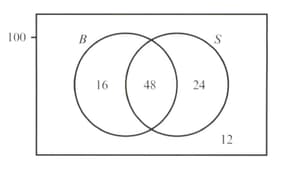A fair -sided die has faces marked and . The score when the die is rolled is the number on the face that the die lands on. The die is rolled twice.
Event is 'one of the scores is exactly less than the other score'.
Event is 'the product of the scores is less than
Determine whether events and are independent, justifying your answer.

Important Questions on Probability
Two hundred children are categorised by gender and by whether or not they own a bicycle. Of the males, own a bicycle, and altogether children do not own a bicycle.
Tabulate these data.
Two hundred children are categorised by gender and by whether or not they own a bicycle. Of the males, own a bicycle, and altogether children do not own a bicycle.
Determine, giving reasons for your answer, whether ownership of a bicycle is independent of gender for these children.
Two hundred children are categorised by gender and by whether or not they own a bicycle. Of the males, own a bicycle, and altogether children do not own a bicycle.
What percentage of the females and what percentage of the males own bicycles?
At an election, it was found that people voted for Party independently of their income group. The following table shows that people from three income groups voted altogether, and that of them voted for Party .
| Low | Medium | High | Totals | |
| Party | ||||
| Totals |
Find the value of , of and of .
The speed limit at a motorway junction is . Information about the speeds and directions in which vehicles were being driven are shown in the following table.
| North | East | South | West | |
| Under limit | ||||
| Over limit |
Providing evidence to support your answer, determine which vehicles' speeds were independent of their direction of travel.
One letter is randomly selected from the six letters in the word BANANA. Find the probability that:
an is selected, given that an is not selected
One letter is randomly selected from the six letters in the word BANANA. Find the probability that:
an is selected, given that an is not selected.
One hundred children were each asked whether they have brothers and whether they have sisters . Their responses are given in the Venn diagram opposite.
Find the probability that a randomly selected child has sisters, given that they have brothers.

